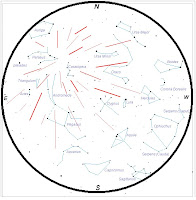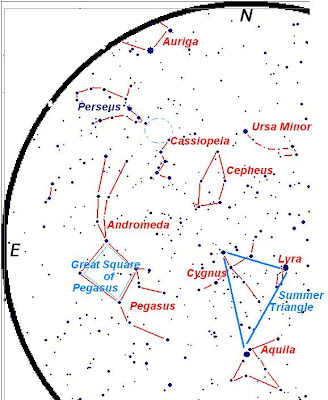.....The most
reliable meteor shower of the year is the Perseid meteor shower, usually
peaking on the night between August 11th and August 12th. In younger
years, this was the one time during the year that I could get the whole
family as interested in astronomy as I was, a situation that I found was
pretty common. I have a lot of good memories of this shower, both
growing up in the southeast, and times that I've visited my wife's
family. Now that we live farther away from our families, and will see
them less often, it is good to have this as a link to the past.
..... Every dark,
moonless night not dominated by city lights,
we can expect to see a few shooting stars per hour, flashing randomly
across the sky. These typically come from one of three sources:
Leftover bits of flotsam and jetsam that have been floating around the
solar system for the last five and a half billion years (cool), little
bits that have been boiled off of comets as they passed around the Sun
(also cool), or nuts/bolts/heat shields/tool boxes that have come off
of space craft and are crashing back down to Earth (less cool). I
lived in central Florida for several years, and when I realized that
probably the bulk of the meteors I was seeing from there were bits and
pieces left over from launches, I admit that some of the romance died.
.....Each
time a comet passes through the inner solar system, if it still has
much of its original ice, that ice will boil off, taking some dust
pebbles with it, and the ice will reflect sunlight, resulting in the bright coma and tail. What happens to this once the comet goes
back to the outer reaches of the solar system? Nothing. That comet
rubble stays in orbit, resulting in the comet's orbit eventually
becoming a dusty tube of gunk around the Sun. If the Earth should pass
through this gunk, then when the particles hit the Earth's atmosphere
they will light up from the heat of friction generated from going from a
temperature of less than three hundred degrees below zero (Fahrenheit)
to thousands of degrees. Since all of these meteors are coming from
the same general area in space, they will appear to come from the same
general area of the sky, meaning that the meteors will all seem to
radiate out from the same point. (Called, reasonably enough, the "radiant".)
the bright coma and tail. What happens to this once the comet goes
back to the outer reaches of the solar system? Nothing. That comet
rubble stays in orbit, resulting in the comet's orbit eventually
becoming a dusty tube of gunk around the Sun. If the Earth should pass
through this gunk, then when the particles hit the Earth's atmosphere
they will light up from the heat of friction generated from going from a
temperature of less than three hundred degrees below zero (Fahrenheit)
to thousands of degrees. Since all of these meteors are coming from
the same general area in space, they will appear to come from the same
general area of the sky, meaning that the meteors will all seem to
radiate out from the same point. (Called, reasonably enough, the "radiant".)
 the bright coma and tail. What happens to this once the comet goes
back to the outer reaches of the solar system? Nothing. That comet
rubble stays in orbit, resulting in the comet's orbit eventually
becoming a dusty tube of gunk around the Sun. If the Earth should pass
through this gunk, then when the particles hit the Earth's atmosphere
they will light up from the heat of friction generated from going from a
temperature of less than three hundred degrees below zero (Fahrenheit)
to thousands of degrees. Since all of these meteors are coming from
the same general area in space, they will appear to come from the same
general area of the sky, meaning that the meteors will all seem to
radiate out from the same point. (Called, reasonably enough, the "radiant".)
the bright coma and tail. What happens to this once the comet goes
back to the outer reaches of the solar system? Nothing. That comet
rubble stays in orbit, resulting in the comet's orbit eventually
becoming a dusty tube of gunk around the Sun. If the Earth should pass
through this gunk, then when the particles hit the Earth's atmosphere
they will light up from the heat of friction generated from going from a
temperature of less than three hundred degrees below zero (Fahrenheit)
to thousands of degrees. Since all of these meteors are coming from
the same general area in space, they will appear to come from the same
general area of the sky, meaning that the meteors will all seem to
radiate out from the same point. (Called, reasonably enough, the "radiant".)
.....Each August, the Earth passes through the remnant trail of the comet Swift-Tuttle,
generating the Perseid meteor shower because the radiant of the
meteors (the dotted circle in the image below) is in the constellation
of Perseus. Meteor showers do not require a telescope or binoculars;
just go outside and look (in this case to the northeast, especially
after midnight).
.....A lot of this is part of the standard run up to a meteor shower. Happily, this year the Moon will have a very small effect on the meteors this year. The Moon will not rise over the horizon until after 1 AM, so it will have a very small effect. This is good. Looking at different sources, the number of meteors per hour for the Perseid Meteor shower is usually given as a number between 60 and 120. (Wow!) Now let's look at that as the sky gets brighter due to the Moon. Even if we take the most generous version, that considers that we can see all the way down to our eyes limit. With the bright Moon, we can't. With an interfering Moon, even if we could see down to fifth magnitude (as opposed to sixth magnitude, our limit), we would go from 120 down to about 46. The full Moon is much more limiting than this, however. Even if we assume a third magnitude limit, we're down to about seven. Per hour. With any bad or humid air, this could limit us to second magnitude (maybe three meteors an hour, if we're lucky), or first (maybe three meteors every four hours). This year, again, we don't have the Moon to worry about.
.....A lot of this is part of the standard run up to a meteor shower. Happily, this year the Moon will have a very small effect on the meteors this year. The Moon will not rise over the horizon until after 1 AM, so it will have a very small effect. This is good. Looking at different sources, the number of meteors per hour for the Perseid Meteor shower is usually given as a number between 60 and 120. (Wow!) Now let's look at that as the sky gets brighter due to the Moon. Even if we take the most generous version, that considers that we can see all the way down to our eyes limit. With the bright Moon, we can't. With an interfering Moon, even if we could see down to fifth magnitude (as opposed to sixth magnitude, our limit), we would go from 120 down to about 46. The full Moon is much more limiting than this, however. Even if we assume a third magnitude limit, we're down to about seven. Per hour. With any bad or humid air, this could limit us to second magnitude (maybe three meteors an hour, if we're lucky), or first (maybe three meteors every four hours). This year, again, we don't have the Moon to worry about.

.....Looking
for Perseids can still be done in the nights leading up to Saturday
night, but the peak will be pretty concentrated on Saturday night/Sunday
morning. Here is a map of the
northeastern part of the sky on Saturday at about midnight.










.svg.png)















